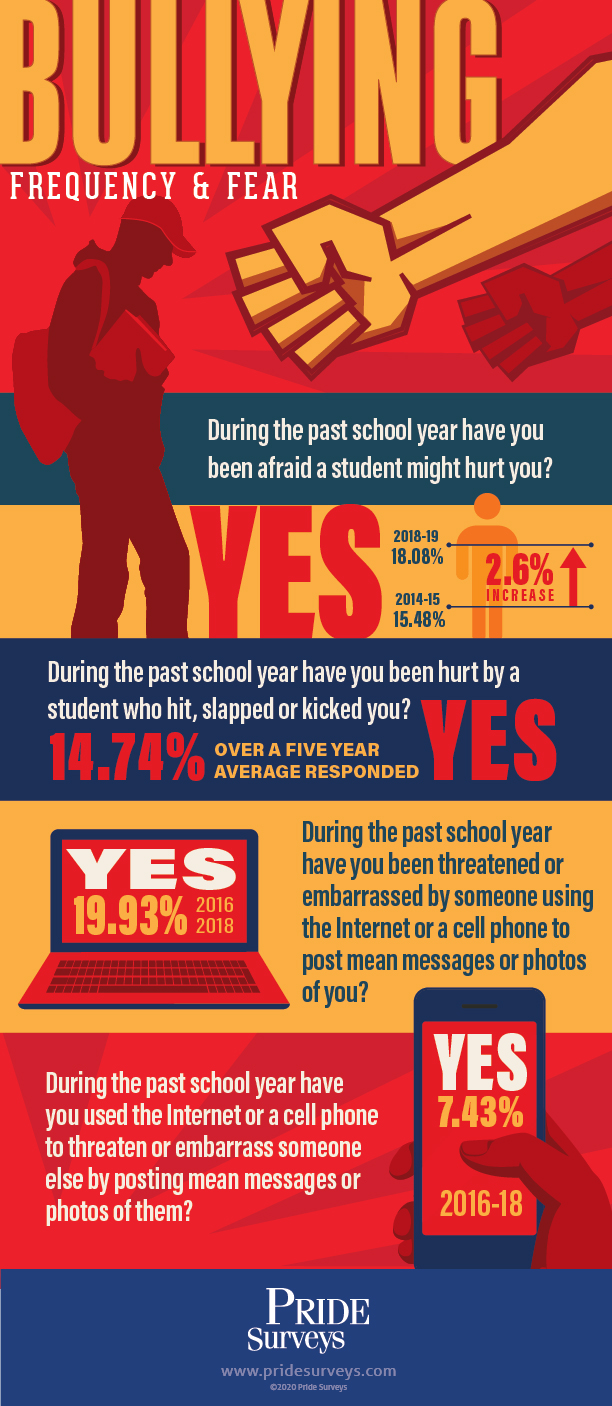Sign up for our information-filled email newsletter

Student Stress and Mental Health During COVID-19

Student stress and mental health is a prevalent and ongoing topic for communities, parents, and educators year-round. With the unexpected occurrence of COVID-19 and students being impacted by distance learning, lack of social interaction, missing graduations, grade delays, and more, it is more important than ever to keep these topics top of mind and to assess regularly.
Drops in grades and an increase in concerning behavior often correlate to student stress and mental health. A Pride Surveys led paper in Alabama examined students feeling threatened in school and how it impacted their English and math test scores. The statistics showed that as students feel more threatened, their scores drop. Students nationwide are oftentimes impacted in their schools by threats and threatening behavior and have a legitimate concern for their safety and the safety of their peers.
2018-19 National Summary Data from Pride Surveys shows that when asked the question, “During the past school year have you been afraid a student might hurt you?”, there was an average of 18.08% of students surveyed who answered “yes.” That number has increased a total of 2.6% over the past four years. Fear of being hurt is a factor in student stress that can negatively impact test scores and student mental health.
From the same data set, the question, “During the past school year have you been hurt by a student who hit, slapped or kicked you?” resulted in an average of 14.74% of students surveyed over five years answering “yes”. This follow-up question shows that many students who are threatened with violence may also be the victim of actual violence. This shows the importance of listening to students’ concerns when they voice them to counselors, teachers, and administrators. While this tells the story of some of the history of in-school related stress due to physical violence and threats of violence, due to COVID-19 and distance learning, a more timely concern currently is that of cyberbullying.

Student Stress and Bullying Statistics
Data that is particularly relevant at this time relates to questions explicitly asked about being threatened or threatening someone over the phone or the internet. KidsHealth.org defines Cyberbullying as “the use of technology to harass, threaten, embarrass, or target another person. By definition, it occurs among young people.” Looking at data from a convenience sample of over 43,000 students over the three year period of 2016-2018, students were asked the question, “During the past school year have you been threatened or embarrassed by someone using the Internet or a cell phone to post mean messages or photos of you?” The resulting average over three years was a 19.93% rate of “yes” responses. When asked, “During the past school year have you used the Internet or a cell phone to threaten or embarrass someone else by posting mean messages or photos of them?”, the question generated an average of 7.43% stating “yes”. These numbers may well increase while students potentially remain out of school full time or part-time in the fall as we continue to track the data.
Pride Surveys works with our community coalition partners to provide the surveys and analytics for physical violence and cyberbullying so we can help them drive change in their communities and schools and reduce student stress. Schools have specific data about fights on campus (SUR data which has to be recorded), but Pride Surveys data shows what the students are reporting so schools can compare and get a better holistic picture of the school climate and students’ online behaviors which can be hard to track.
Parents can help combat the issues by having open conversations with their kids about what cyberbullying is and any issues they are facing. They can also help prevent problems by being active and engaged participants in their lives, knowing who their friends are, monitoring changes in grades or behavior, and establishing rules and limits about online use. Parents can also try tracking resources that meet their comfort levels, such as MSpy and The Spy Bubble, which will document the sites they visit and the types of media being shared and consumed.
The more we work together between Pride Surveys, community coalitions, and schools, the more we can help navigate situations that lead to student stress and mental health issues, whether they stem from cyberbullying or physical threats. Pride Surveys is here and available to discuss appropriate questions for student surveys, many of which we are now offering online. Contact us today to learn more.
Resources:

- Social Media Addiction Mental Health Impact
- Understanding Individual Risk Factors: Helping Parents Support Children’s Mental Health
- Student Mental Health Challenges Over the Summer and Resources to Address Them
- Planning and Executing a Coalition Part 3: Communication and Media
- How Community Coalitions Can Help Students Avoid the Summer Slide




